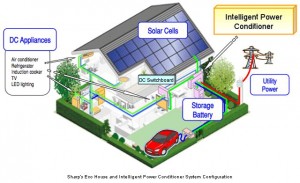The best hope we have on Earth for averting the worst impacts of climate change is a pretty simple formula: a huge amount of renewable energy, with surpluses stored in technologies like cheap batteries, and all our transportation running on electricity.
Well, actually there’s another solution: we could de-industrialize and return to the Stone Age. Or humans could die off suddenly from disease or war. But I prefer the first approach.
 The critical piece to this energy and transportation transition is bringing the cost of these technologies down, and two articles this week indicate that we’re making progress. First, solar prices have come down dramatically, leading to huge new demand which is now causing a shortage of panels. Analysts don’t expect solar panel prices to rise in response, but it is prompting companies like SolarCity to invest heavily in new solar PV production facilities. Underlying this dynamic is the fact that panels now sell for 76 cents a watt, compared with $2.01 at the end of 2010 (including a 12 percent price drop just this year).
The critical piece to this energy and transportation transition is bringing the cost of these technologies down, and two articles this week indicate that we’re making progress. First, solar prices have come down dramatically, leading to huge new demand which is now causing a shortage of panels. Analysts don’t expect solar panel prices to rise in response, but it is prompting companies like SolarCity to invest heavily in new solar PV production facilities. Underlying this dynamic is the fact that panels now sell for 76 cents a watt, compared with $2.01 at the end of 2010 (including a 12 percent price drop just this year).
Second, wind prices are falling, making wind energy competitive with natural gas in some parts of the country:
After topping out at nearly $70 per megawatt hour in 2009, the national average levelized price of wind purchase agreements fell to around $25 last year, the [U.S. Department of Energy] report sad. That means wind electricity costs about 2.5 cents per kilowatt hour, a highly competitive price in some parts of the country.
Finally, as I blogged about earlier this week, electric vehicle battery prices have dropped 40% since 2010.
This is all great news for the possibility of an economically painless transition to a sustainable economy. Credit so far is due to the private sector for the innovation and investment. But this is also a clear sign that government policies around the world to boost these markets are having success. On the solar and wind side, the federal government offers tax credits for investors, while many states have renewable energy mandates, financial incentives, and utility programs that reward customers for installing renewables. The federal government also provides a tax credit for electric vehicle purchases and loans and grants for clean technology startups (in some ways, the 2009 economic stimulus was Obama’s true climate change bill, given the support that legislation gave to game-changing companies like Tesla). And states like California offer cash rebates and other incentives for EV purchases, as well as a mandate for utilities to buy more energy storage.
Obviously we still have a long way to go, but the cost trends are very encouraging. And they should reinforce the political will to keep the incentives going while the private sector continues to do its part to bring down costs.
One thought on “Wind, Solar, and Battery Price Decreases Point To Success Of Government Policies”
-
Pingback: Can You Be Both Pro-Electric Vehicle And Pro-Transit? | Ethan Elkind
Leave a Reply
You must be logged in to post a comment.


